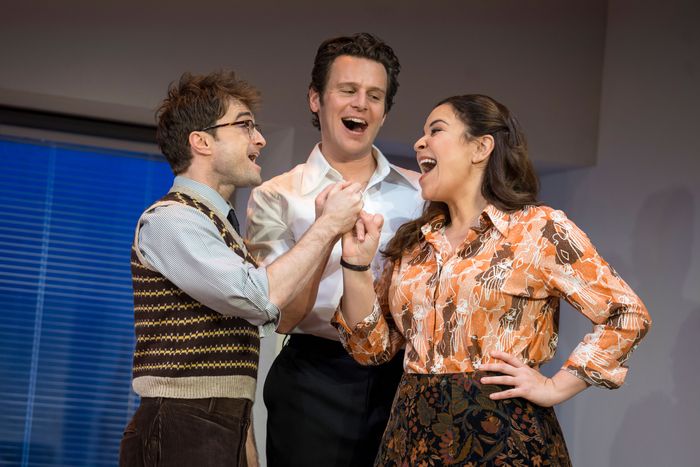
Franklin Shepard’s California mansion, rendered onstage at New York Theatre Workshop, a David Hockney scene: blocky, mostly white, mid-century chic with a wall of glass that makes you imagine the smell of sagebrush, star jasmine, and chlorine. Set and costume designer Soutra Gilmour has placed ferns along the ramparts, at the same height where the band for this production of Merrily We Roll Along is hidden in a second-floor studio.
I kept thinking about the greenery as the notoriously difficult Stephen Sondheim and George Furth musical started flashing backward in time, because the ferns stay onstage throughout. In director Maria Friedman’s rendering of Merrily, everything seems to take place within the house in Bel Air (dressed with new props in each scene to suggest everything from divorce court to New York dive bar) that Frank has bought with money from a big movie deal, alienating his close friends on his way there. The show works backward from the curdled Los Angeles present of 1976 to Frank and his friends’ early years in New York, and in this staging, we never quite leave the present behind. It’s a way of framing the musical that powers its structural gambit: as if it were all the death dream of a sellout, or, because he’s still very much alive, of the idealistic part of him. Frank turns back. The ferns keep growing.
Merrily We Roll Along always has to be introduced as the Sondheim show that does not work, even if that’s a black mark it doesn’t deserve. Yes, the original version did open and close in a fortnight back in 1981, and yes, it broke up the Sondheim–Hal Prince collaboration (you can watch a whole documentary about that), but given the number of times that people have been drawn to restage and revise Merrily, there just has to be something there. (It’s not like people are doing The Frogs nearly as often.) The plot, based on the Kaufman and Hart play, can be tough going, given that you start with a bunch of people being assholes to one another and by going backward in time find out why we should care about them. But the music is gorgeous and inventive, as Sondheim disassembles the structures of classic musical songwriting, introducing reprises before the primary melodies as if he were fitting the score into a cryptic crossword. Sucker for high-concept muddles that I am, I haven’t ever disliked a version of Merrily I’ve seen (I enjoyed the way Fiasco’s recent one-act version gave it backward momentum). Friedman’s straightforward and finely polished version, however ramshackle certain aspects of the show remain, gives Merrily new emotional depth, especially in its rendering of Frank. You feel powerfully his ache to get back to the past, which is quite an accomplishment—the guy does have some sweet digs in Bel Air.
A large part of that lies just in the casting. It is hard to hate anyone played by Jonathan Groff, who lends an innate sweetness to the character and has a silvery voice that lines both his songs and his dialogue with melancholy. We meet him in the midst of a big party for a movie that people say to his face they love and knock behind his back, and he’s playing the part of a wheeler-dealer while also communicating that this character is playacting too (Gilmour has Groff in a finely tailored white shirt and black pants, switching him into looser versions in the same colors as time reverses). His old pal Mary, played by Lindsay Mendez, has stumbled into the bash and is getting drunk and sniping at Frank, who has gone from writing music to producing dumb movies. Furth’s early book scenes contain so much bitterness that you just have to hang onto the promise that these actors are charming enough to reveal more later on. Star-cast as this production is, you already know there will be more than meets the eye.
So, working our way back in time a bit further, we meet Daniel Radcliffe’s Charley Kringas, Frank’s former friend and lyricist, who gets fed up with Frank’s way of infinitely delaying their passion project. Radcliffe, born to play a tensed-up worrywart, pretty much enters the show having to sing an 11-o’clock breakdown number before 8:30. Charley’s live-on-air denunciation of his partner in “Franklin Shepard, Inc.” immediately wins you over. Friedman, whose version of Merrily originated in London, makes much of the contrast between both Groff’s and Radcliffe’s demeanor (one smooth, one nearly always vibrating with energy) and physical size (Groff lifts Radcliffe on his back twice). You can see her background as an actor in her direction, the way that she’s encouraged them to find as many telling gestures as possible within each individual scene or song. When the trio of Groff, Radcliffe, and Mendez jump into “Old Friends,” you feel as if you’re in a scene-study workshop with them, full of rambunctious energy that endears you to them en masse. They are never sweeter than when doing their little triple-pinky promise.
Friedman is seemingly so intent on uncovering the possibilities of emotional meaning in each scene, however, that her production can get away from itself. She’s overfond of underlining a moment of realization by pinpointing Groff in a spotlight and having him give a significant exhalation to mark a realization. In her attempts to get some of the less central characters to make an impact, some of the performers seem to have been egged toward overemoting. Katie Rose Clarke, as Frank’s first wife, Beth, delivers the first iteration of “Not a Day Goes By” as a full-on meltdown, distorting what the song can easily convey in its lyrics, while Krystal Joy Brown, playing his second wife, Gussie, is first big as a resentful scold and later (which is earlier) big as an ominous vamp. (To be fair, she doesn’t have much depth in the book to cling to.) Some of this reflects the tryout nature of this specific production, which is clearly intended to transfer to Broadway, and many of those choices are sure to be evaluated along the way to see which are sticking. (If I have any say in the matter, I could live without as much of Frank’s son, who is deployed for cuteness in a way that becomes cloying.)
Aside from the framing around Frank’s memory, what sticks strongest in this version is Lindsay Mendez’s Mary. I’ve always felt bad for the character, whose story is grim: She’s an aspiring writer; she’s in love with Frank but doesn’t get him; she writes a best-seller (a win!) but then becomes an alcoholic and (horror of horrors) a drama critic. As the show starts, Charley has won a Pulitzer, Frank is rich, and she’s ended up broke and drunk, but in Mendez’s performance, she has faith, I think. Faith in her friends’ talents and in their ability to eventually get it together and right one another’s wrongs. She’s the one who, near the top of the show, still believes that life could maybe be “Like It Was,” and the one who knows by the end that Frank has come into her life and “you don’t go away.” It’s this faith in Frank that drags her down but also holds the friends together for as long as it does. Mendez has this winsome smile that her Mary seems to hold on to even when someone is delivering her the worst of news. It’s the face of someone who can see life sending a punch at her and instead of dodging stands still because she thinks she deserves the impact. If all of this Merrily is happening in Frank’s imagination, the Mary we see is some aspect of him punishing himself, too. He looks backward to find her looking forward toward a reconciliation that doesn’t come.
Among Sondheim musicals, Merrily feels especially precious now because it invites the possibility of some personal glimpse at the songwriter himself. Even Sondheim, who forever resisted direct comparisons between his life and his work, has said the “Opening Doors” sequence of Frank, Charley, and Mary hustling in their early careers is close to autobiographical. Then, because Mary’s name is Mary, you can’t help thinking of Mary Rodgers, and if you’ve read her recent memoir (written with Jesse Green), you’ll see even more refractions of personal history in Merrily. Is there something real in Mary and Frank’s dynamic of Sondheim and Rodgers’s trial marriage? At the very least, the fact that Gussie demands that Frank tell her a series of honest truths at a party recalls the parlor game of “hostilities” that Rodgers describes in that book. And then you consider that Maria Friedman herself knew Sondheim well, as both a collaborator and a friend, and you wonder what observations she might’ve had that ended up in this production. She’s doing an archaeological dig along with Frank. Although there’s no Rosetta stone to fix the show, plenty of little artifacts of meaning, left by an author we can no longer know completely, make themselves known. The production becomes about this endless return to the past, for Frank and for the show itself. He’s on this trip through all the moments of near harmony with Charley and Mary, all these places where, if only they had expressed themselves better, life might have turned around (even that last glorious roof scene of “Our Time” contains intimations of what might go astray). In the brokenness of that history lies the allure of the show. What was imperfect is more interesting, as dramatic material, than what worked. It gives us imagined agency. If only we could reach back and adjust the past by a few degrees, we’d see something in the present that is forever obscured — and all the while, time itself ticks merrily forward and the ferns keep growing.





